Xanten: Vetera I
Q532466Xanten: city on the Lower Rhine, close to the Roman legionary base Vetera and the ancient city called Colonia Ulpia Traiana.
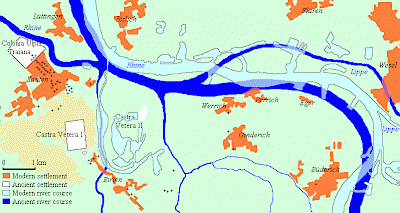
Castra Vetera was founded by the Roman commander Drusus, a stepson of the emperor Augustus, on the hill now known as Fürstenberg. The Roman author Tacitus describes this hill as steep and adds that it was approachable from one side, which must have been the one to the south.
Probably, the fortress was constructed in 13/12 BCE. Situated sixty Roman miles below the capital of Germania Inferior, Colonia Claudia Ara Agrippinensium (modern Cologne), it controlled the confluence of the rivers Rhine and Lippe. It is not known what the name of the settlement means: it may simply mean "the old castle" but Vetera may also be the Latin rendering of a native name. If so, the autochtoneous settlement may still be discovered in the neighborhood. It cannot have been a large town, because the area was not densely populated; in fact, it is only after a resettlement of Germanic tribes after c. 8 BCE that we hear of the local tribe, the Cugerni.
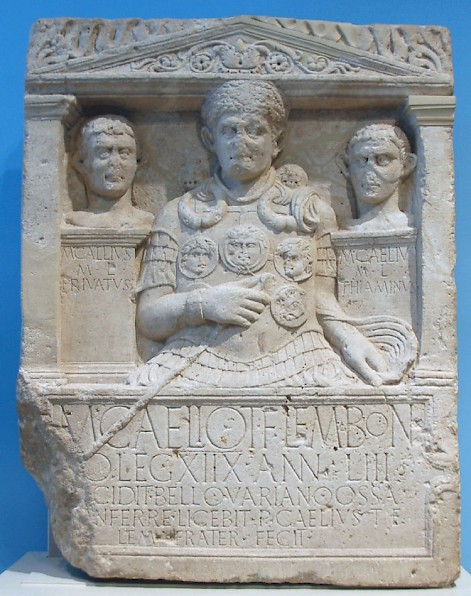
Drusus used Castra Vetera as one of his bases when he invaded the east bank of the Rhine. Archaeologists have not researched the earliest traces of this base yet (they have concentrated on the large camp from the age of Nero); this makes it hard to find out which legions were originally based on the Fürstenberg. However, the cenotaph of Marcus Caelius mentions the Eighteenth Legion, which suggests that at least a part of the army of Publius Quinctilius Varus, which was annihilated in the battle in the Teutoburg Forest (September 9 CE), was stationed at the Fürstenberg.
Another unit at Vetera may have been the Seventeenth Legion, but this hypothesis is essentially based on the fact that we do not know where else it can have been. The discovery of one single pot sherd in, say, Nijmegen or Haltern, is sufficient to falsify this hypothesis.
After the battle in the Teutoburg forest, Lucius Nonius Asprenas occupied the site and prevented the Germanic tribes from crossing the Rhine. After this disaster, the castle was rebuilt, probably by Drusus' brother Tiberius, the future emperor. The fortifications, made of wood, were wide enough to offer accommodation to two legions, V Alaudae and XXI Rapax. Both units took part in the Germanic campaigns of Germanicus in the first years of the reign of Tiberius (14-16) and the unsuccessful campaign against the Frisians of 28.
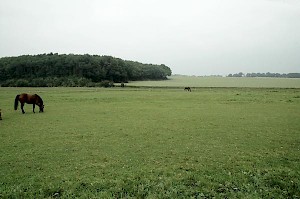
In the late twenties or early thirties, Castra Vetera was destroyed - probably by the Romans themselves - and rebuilt on an equalized terrain. (The remains of the amphitheater, with a capacity of 10,000 people, are still visible). It is interesting to note that food supplies were now more often brought to the castle in Roman earthenware. Is it possible that the construction of a river port enabled transport by water? Or do we have to assume that this ceramics were produced in the kilns north of the fortress?
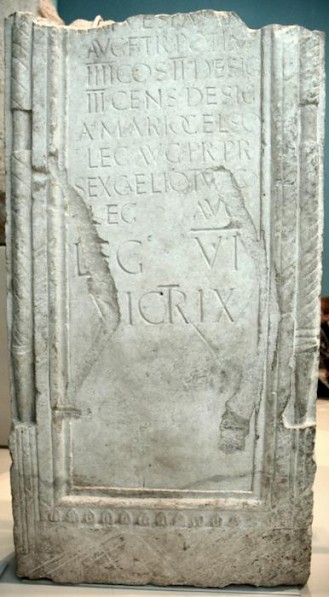
In or immediately after 43, XXI Rapax was replaced by XV Primigenia, a new legion. The camp was rebuilt again, and this time natural stone from the Brohl valley and bricks were used as foundation. One of the soldiers who lived at Xanten was Pliny the Elder. A bridle lost by the author of the Natural history was found by archaeologists and is now in the British Museum.
In the early sixties, the entire castle was rebuilt. This was the fortress that was razed to the ground during the Batavian revolt after a siege that lasted the entire fall and winter of 69-70. The soldiers who had defended Castra Vetera were murdered after their surrender and V Alaudae and XV Primigenia were never reconstituted.
Much Roman military artifacts have been discovered during gravel extractions at Xanten-Wardt, just north of the site that was later occupied by the Colonia Ulpia Traiana. Because they all belong to the same period, it is likely that this was the loot taken from Vetera and dedicated to the gods.
In the summer of 70, Petillius Cerialis reconquered Germania Inferior. The decisive battle took place near Vetera. A monument, found near Vynen north of Xanten, reminds of the liberation.
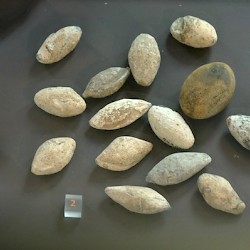 Xanten-Fürstenberg, Slingstones |
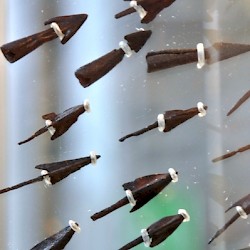 Xanten-Fürstenberg, Arrowheads |
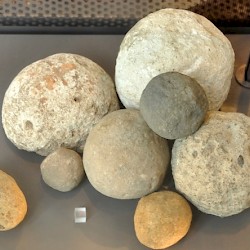 Xanten-Fürstenberg, Catapult stones |